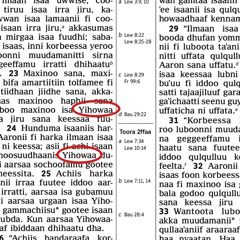

This Afaan Oromoo Bible app supports parallel studying in split window for reading two bibles. This Afaan Oromoo Bible app additionally has day by day verse app widget and in app notification. This Afaan Oromoo Bible app has reading plans to assist you with daily devotions and bible examine. This Afaan Oromoo Bible app comes with extra downloadable bibles in English and Amharic. Oromiffa Bible (Macaafa Qulqulluu) also conatians Strongs concordance, search, highlight and verse image features.Īfaan Oromo Bible (Macaafa Qulqulluu) is superbly designed holy bible app for straightforward studying of the word of God.Īfaan Oromo Bible - Oromo bible (Afaan Oromoo Macaafa Qulqulluu) - Oromiffa Bible
#Kitaaba qulqulluu afaan oromoo Offline#
The Arabic script has also been used intermittently in areas with Muslim populations.Afaan Oromoo Bible is an offline Oromo bible (Macaafa Qulqulluu) with KJV English bible. in word-final environments or as part of consonant clusters).

It is largely alphasyllabic in nature, but lacks the inherent vowel present in many such systems in actual use, all consonant characters are obligatorially marked either with vowel signs (producing CV syllables) or with separate marks used to denote long consonants and consonants not followed by a vowel (e.g. Despite structural and organizational influences from Ge'ez and the Arabic script, it is a graphically-independent creation designed specifically for Oromo phonology. The Sapalo script was an indigenous Oromo script invented by Sheikh Bakri Sapalo (1895-1980 also known by his birth name, Abubaker Usman Odaa) in the late 1950s, and used underground afterwards. In Kenya, the Borana and Waata also use Roman letters but with different systems. With the adoption of Qubee, it is believed more texts were written in the Oromo language between 19 than in the previous 100 years. Various versions of the Latin-based orthography had been used previously, mostly by Oromos outside of Ethiopia and by the OLF by the late 1970s (Heine 1986). Oromo is written with a Latin alphabet called Qubee which was formally adopted in 1991. It is used as internet language for federal websites along with Tigrinya. It is a language of primary education in Oromia, Harar, Dire Dawa, Benishangul-Gumuz and Addis Ababa and of the Oromia Zone in the Amhara Region. Oromo serves as the official working language of the Oromia, Harar and Dire Dawa regional states and of the Oromia Zone in the Amhara Region. It is also spoken by smaller numbers of emigrants in other African countries such as South Africa, Libya, Egypt and Sudan. Forms of Oromo are spoken as a first language by more than 35 million Oromo people in Ethiopia and by an additional half-million in parts of northern and eastern Kenya. It is also the most widely spoken Cushitic language and the fourth-most widely spoken language of Africa, after Arabic, Hausa and Swahili. With 33.8% Oromo speakers, followed by 29.3% of Amharic speakers, Oromo is the most widely spoken language in Ethiopia. It is native to the Ethiopian state of Oromia and spoken predominantly by the Oromo people and neighbouring ethnic groups in the Horn of Africa. Oromo ( / ˈ ɒr əm oʊ/ or / ɔː ˈ r oʊ m oʊ/ Oromo: Afaan Oromoo) is an Afroasiatic language belonging to the Cushitic branch. Macaafa Qulqulluu / Oromo Holy Bible pulbished as Afaan Oromoo - Hiikaa Haaraa / New Translation in Latin Script / Bible Society of Ethiopia 1997 / Black Vinyl Bound / Oromo Latin Bible BSE-UBS / CL042LT


 0 kommentar(er)
0 kommentar(er)
